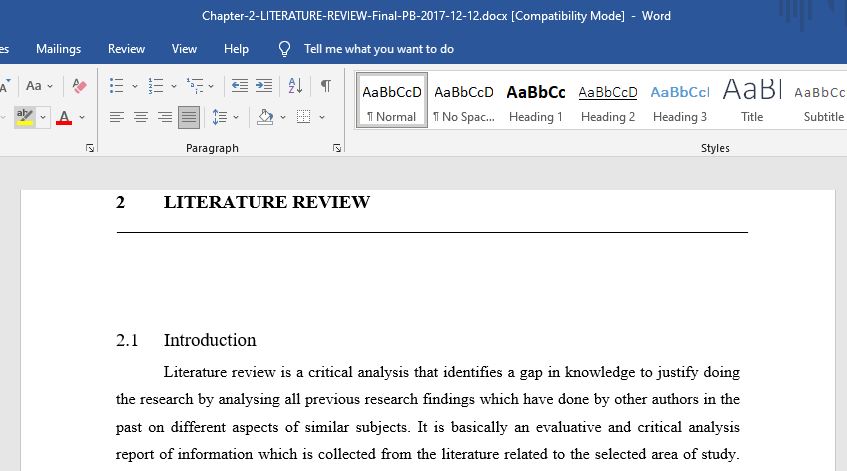Research objectives
| Project Details | |||||
| Paper Topic | : | Chapter 6-Discussion | |||
| Style | : | Harvard | Language Style | : | English (U.K.) |
| Type of Assignment | : | Article | : | ||
| Acedemic Level | : | Post Graduate Level | : | ||
| Number of Sources | : | 1 | |||
| Order Instructions | |||||
Chapter 6 – Discussion
Discussion section, intends to mainly revisit/discuss empirical findings, but mention why empirical work necessary and show how your findings relate and contribute to existing knowledge
Overall structure:
6.1 Chapter Introduction (0.5page)
6.2 Revisiting the Research Objective (1page)
6.3 Relating the Findings of the Conceptual Study to the Existing Literature (7-8p)
6.4 Relating the Findings of the Phenomenological Study to the Existing Literature (7-8p)
6.5 Addressing the Research Objective (2p)
6.5 Chapter Summary (0.5-1page)
Detail Structure:
6.1 Chapter Introduction (0.5page)
Write Chapter intro, as always.
It is a more abstract version of the whole discussion chapter.
6.2 Revisiting the Research Objective (1page)
– Link to Lit Review section, 2.8
– use exact same wording for Research objective and questions (highlight in bold)
Research questions are clearly formulated in the literature review (ch2)
1st paragraph: Objective of study overall, re-state research objective in bold
Then link to phenomenological inquiry
2nd paragraph: summarise what you did and how (linked to methods chapter (chapter 3)). First, organisational level analysis through conceptual study. Second, individual level analysis through phenomenological study.
3rd paragraph: State research questions in bold
4th paragraph: Goal of research à theory building NOT THEORY TESTING/ NO CASE STUDIES/ NO POSITIVISM!!
6.3 Relating the Findings of the Conceptual Study to the Existing Literature
Shift discussion (4.5) from Chapter 4 including 2nd model (Figure 20 from ch4)
Add a table with all propositions
PUT NEW MODEL HERE (Figure 20 from ch4) and explain it again in one paragraph
– relevant propositions for each body of literature
– Use “4.5 How does the model answer the research question” content for 6.3.1, 6.3.2 and 6.3.3 as explained below. Select the content from 4.5 according to each dimension (Content, Actor and Process). You need to expand it a little bit more to make it clear and also meet the page count
6.3.1 Relating the Findings of the Conceptual Study to the Content-Perspective of IT Governance (2p)
1st: revisit key statements from content perspective
(e.g. Content Perspective of IT Governance says X. This is what I found…this is what I mean)
2nd: use your text and link to existing literature
3rd: clear statement of what we now know after your research is out
6.3.2 Relating the Findings of the Conceptual Study to the Actor-Perspective of IT Governance (2p)
1st: revisit key statements from actor perspective
2nd: use your text and link to existing literature
3rd: clear statement of what we now know after your research is out
6.3.3 Relating the Findings of the Conceptual Study to the Process-Perspective of IT Governance (2p)
1st: revisit key statements from process perspective
2nd: use your text and link to existing literature
3rd: clear statement of what we now know after your research is out
6.4 Relating the Findings of the Phenomenological Study to the Existing Literature
Put phenomenological model here (attached) plus intro- also guide the reader with a paragraph
6.4.1 Relating the Findings of the Phenomenological Study to the Content-Perspective of IT Governance (2p)
– what decision is all about
(same pattern as above 1st, 2nd and 3rd)
6.4.2 Relating the Findings of the Phenomenological Study to the Actor-Perspective of IT Governance (2p)
– What is it that people do à so it is about the practices
6.4.3 Relating the Findings of the Phenomenological Study to the Process-Perspective of IT Governance (2p)
– I identified 4 phases of the phenomenological study (ch5) which are Externalities, Conception, Conclusion and outcome; and explain each big picture
Include the propositions. just the relevant ones for each body of literature (Content, Actor or Process)
For example, proposition x from phenomenological study relates to Actor perspective so explain it in 6.4.2
6.5 Addressing the Research Objective (2p)
Reiterate your research questions (bold) and provide short answers for each (summary style).
Also try to give a story in a short very well written paragraph or two about the outcome model of the phenomenological study:
If the in ITG practices, decision making goes through official channels which are the top constructs of the phenomenological study, i.e. go through Consultation, Assessment and Endorsement then it’s more likely that the benefits are realised.
But if decision making goes through un-official channels which are the bottom constructs of the phenomenological study, i.e. go through Inception and Objection then it’s more likely that the conflicts happen.
6.5 Chapter Summary
Answer preview:
Word:7, 700

